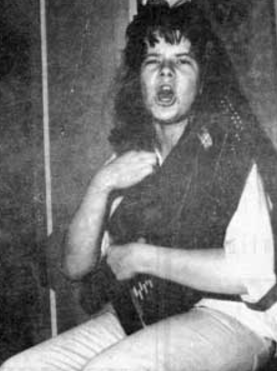Meditation
on Blue
Chicory
blooms blue
against the sun-bleached lawn. Drought
makes these flowers fierce.
against the sun-bleached lawn. Drought
makes these flowers fierce.
As the
YouTube video of Janis Joplin and the typewriter streams from the laptop,
Callie imagines that someone’s girlfriend sits with her hands poised over the
keyboard of her graduation present. A man operates the tape
recorder. Another man plays guitar. No one’s girlfriend, Janis sings
“Trouble in Mind.” Her voice doesn’t yet burn and scorch. Neither
does her laughter.
This
picture is too simple. Too simple.
At the
very least, Janis might have been playing, too. Callie sees the picture of
her with a guitar. Not yet charred in the flame of California sunshine and
heroin, Janis sings about going down to the Texas river that winds through
humidity and past plants you don’t find out west. Perhaps a young man was
typing. Men typed in the military back then. Callie pictures Radar
O’Reilly, glasses and all, typing nonsense while Janis sang about how blue she
was. Now is the time for all good men to come to the aid of our
party. The quick brown fox jumps over the lazy dog while young Janis
sings.
Birds
seeking water
in gutters find only
last year’s maple leaves.
in gutters find only
last year’s maple leaves.
[a haibun that I wrote after Angelee Deodhar died]

Janis Joplin in the early 1960s
Matsuo Bashō coined the term "haibun" in 1690 to describe poems that combined haiku and Chinese prose pieces with vernacular subject matter and language. Traditional haibun were typically short descriptions of a place, person or object, or a diary of a journey or other series of events in the poet's life. Since then it has evolved considerably and may vary widely in form, but it generally consists of 1 or more paragraphs of prose written in a concise, imagistic haikai style, and 1 or more haiku. ("Haibun" means "haikai writings," originally comic, unorthodox, vulgar poetry until Bashō transformed it into more serious writing.) Angelee Deodhar, who died in 2018, was an Indian ophthalmologist who discovered English-language haiku at 42, in a the American poery journal "Potpourri" while recuperating from a pulmonary thromboembolism; she began translating it into Hindi and then writing her own, and eventually concentrating on haibun. A day after her death "Contemporary Haibun" published one of her final works:
ReplyDeletesummer heat…
finally letting go
the tangled kite
However, this is the one that she regarded as her "jisei" (death verse):
water-worn boulder
so smooth now
against callused feet
In June 1964 Janis Joplin went to Jorma Kaukonen's apartment in Santa Clara, California, to rehearse for a gig they were booked for at the Coffee Gallery in San Francisco. As he taped a number of songs they played, his wife Margarita was typing a letter. Next year his Santa Clara University classmate Paul Kantner persuaded him to join a band he was forming with Marty Balin, who was then leading a folk music quartet called the Town Criers. The group was formed as the house band for a new nightclub, The Matrix, that Balin was setting up. They named themselves after one of Kaukonen's friend's nicknames for himself Blind Thomas Jefferson Airplane (because he was an afficianado of the blues played earlier in the century by Blind Lemon Jefferson); Jefferson Airplane was joined by Kaukonen's high school buddy from Washington, DC, Jack Casady, who had just arrived in San Francisco 2 weeks earlier. (Kaukonen and Casady later formed Hot Tuna, a subgroup within Jefferson Airplane which continued after the main group disbanded). Joplin returned home to Texas and was considering an offer to join the 13th Floor Elevators, but was invited to return to San Francisco to join a new, experimental band that Chet Helms managed. She joined Big Brother and the Holding Company in 1966, and as the musicians meshed their very different styles the band became more disciplined and structured. In the 1970s, after Joplin's death, the 6 songs taped at the Kaukonen apartment became widely bootlegged as "The Typewriter Tape. The sentence "The quick brown fox jumps over the lazy dog" is a traditional practice exercise for tyro typists since it contains all of the letters of the alphabet.
Radar O'Reilly was a character in Rihard Hooker's 1968 novel "MASH: A Novel About Three Army Doctors," based on a company clerk that Hooker served with as a surgeon in the Mobile Army Surgical Hospital during the Korean War. Ring Lardner, Jr., adapted the novel for film, and director Robert Altman cast Gary Burghoff in the role in the 1970 movie "M.A.S.H." When Larry Gelbart adapted it into a TV series, Burghoff was the only actor to reprise his role. He played the part for 7 seasons (1972-1979) and returned to the role the following year for a special 2-part farewell episode and again for 2 episodes of the spinoff series "AfterMASH" in 1983. Burghoff tried to recreate the role for "W.A.L.T.E.R.," another spinoff series in 1984, but it only aired once and was pre-empted on the west coast by the network's coverage of the Democratic National Convention.
Thank you,Duane. I was a great admirer and friend of Angelee.
ReplyDeleteI always enjoy reading about Janis Joplin and to think you made it into a haibun.
Angelee would be pleased that you're writing about your own subject.